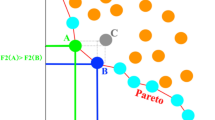Abstract
The max-cut problem is a classical NP-hard problem in graph theory. In this paper, we adopt a local search method, called MCFM, which is a simple modification of the Fiduccia-Mattheyses heuristic method in Fiduccia and Mattheyses (Proc. ACM/IEEE DAC, pp. 175–181, 1982) for the circuit partitioning problem in very large scale integration of circuits and systems. The method uses much less computational cost than general local search methods. Then, an auxiliary function is presented which has the same global maximizers as the max-cut problem. We show that maximization of the function using MCFM can escape successfully from previously converged discrete local maximizers by taking increasing values of a parameter. An algorithm is proposed for the max-cut problem, by maximizing the auxiliary function using MCFM from random initial solutions. Computational experiments were conducted on three sets of standard test instances from the literature. Experimental results show that the proposed algorithm is effective for the three sets of standard test instances.




Similar content being viewed by others
References
Barahona, F., Grötschel, M., & Reinelt, G. (1988). An application of combinatorial optimization to statistical physical and circuit layout design. Operational Research, 36, 493–513.
Benson, S., Ye, Y., & Zhang, X. (1999). Mixed linear and semidefinite programming for combinatorial and quadratic optimization. Optimization Methods & Software, 11, 515–544.
Burer, S., & Monteiro, R. D. C. (2001). A projected gradient algorithm for solving the maxcut SDP problem. Optimization Methods & Software, 15, 175–200.
Burer, S., Monteiro, R. D. C., & Zhang, Y. (2001). Rank-two relation heuristics for max-cut and other binary quadratic programs. SIAM Journal on Optimization, 12, 503–521.
Chang, K. C., & Du, D.-Z. (1987). Efficient algorithms for layer assignment problems. IEEE Transactions on Computer-Aided Design of Integrated Circuits and Systems, 6, 67–78.
Festa, P., Pardalos, P. M., Resende, M. G. C., & Ribeiro, C. C. (2002). Randomized heuristics for max-cut problem. Optimization Methods & Software, 17, 1033–1058.
Festa, P., & Resende, M. G. C. (2003). CIRCUT+PR: a rank-2 heuristic with path-relinking for MAX-CUT. In Extended abstracts of the fifth metaheuristics international conference MIC2003, Kyoto, Japan.
Fiduccia, C. M., & Mattheyses, R. M. (1982). A linear time heuristic for improving network partitions. In Proc. ACM/IEEE DAC (pp. 175–181).
Garey, M., Johnson, D., & Stochmeter, L. (1976). Some simplified NP-complete graph problems. Theoretical Computer Science, 1, 237–267.
Goemans, M. X., & Williams, D. P. (1995). Improved approximation algorithms for Max-Cut and satisfiability problems using semidefinite programming. Journal of the ACM, 42, 1115–1145.
Han, Q. M., Ye, Y., & Zhang, J. (2002). An improved rounding method and semidefinite programming relaxation for graph partition. Mathematical Programming, 92, 509–535.
Helmberg, C., & Rendl, F. (2000). A spectral bundle method for semidefinite programming. SIAM Journal on Optimization, 10, 673–696.
Alperin, H., & Nowak, I. (2005). Lagrangian smoothing heuristics for Max-Cut. Journal of Heuristics, 11, 447–463.
Karp, R. M. (1972). Reducibility among combinatorial problems. In R. Miller & J. Thatcher (Eds.), Complexity of computer computations (pp. 85–103). New York: Plenum Press.
Liu, H. W., Wang, S. H., & Liu, S. Y. (2004). Feasible direction algorithm for solving SDP relaxation of the quadratic {−1,1} programming. Optimization Methods & Software, 19, 125–136.
Poljak, S., & Tuza, Z. (1995). The Max-Cut problem: a survey. In W. Cook, L. Lovàsz & P. Seymour (Eds.), DIMACS series in discrete mathematics and computer science. Special year on combinatorial optimization. Providence: Am. Math. Soc.
Ling, A.-F., Xu, C.-X., & Xu, F.-M. (2008). A discrete filled function algorithm for approximate global solutions of max-cut problems. Journal of Computational and Applied Mathematics, 220, 643–660.
Ling, A.-F., Xu, C.-X., & Xu, F.-M. (2009). A discrete filled function algorithm embedded with continuous approximation for solving max-cut problems. European Journal of Operational Research, 197, 519–531.
Sahni, S., & Gonzales, T. (1976). P-complete approximation problem. Journal of the ACM, 23, 555–565.
Xu, C.-X., He, X.-L., & Xu, F.-M. (2006). An effective continuous algorithm for approximate solutions of large scale max-cut problems. Journal of Computational Mathematics, 24, 749–760.
Xu, F.-M., Xu, C.-X., & Li, X.-S. (2007). A continuation algorithm for Max-Cut problem. Acta Mathematica Sinica. English Series, 23, 1257–1264.
Zhu, W. X., & Fan, H. (2009). A discrete dynamic convexized method for nonlinear integer programming. Journal of Computational and Applied Mathematics, 223, 356–373.
Zhu, W. X., & Ali, M. M. (2009). Discrete dynamic convexized method for nonlinear constrained integer programming. Computers & Operations Research, 36, 2723–2728.
Author information
Authors and Affiliations
Corresponding author
Additional information
This research was supported partially by the National Natural Science Foundation of China under Grants 10931003 and 61170308, the National Key Basic Research Special Foundation (NKBRSF) of China under Grant 2011CB808000, the Research Fund for the Doctoral Program (RFDP) of China under Grant 20093514110004, and the Science and Technology Project of the Education Bureau of Fujian, China, under Grant JA11201.
Rights and permissions
About this article
Cite this article
Lin, G., Zhu, W. A discrete dynamic convexized method for the max-cut problem. Ann Oper Res 196, 371–390 (2012). https://doi.org/10.1007/s10479-012-1133-2
Published:
Issue Date:
DOI: https://doi.org/10.1007/s10479-012-1133-2




